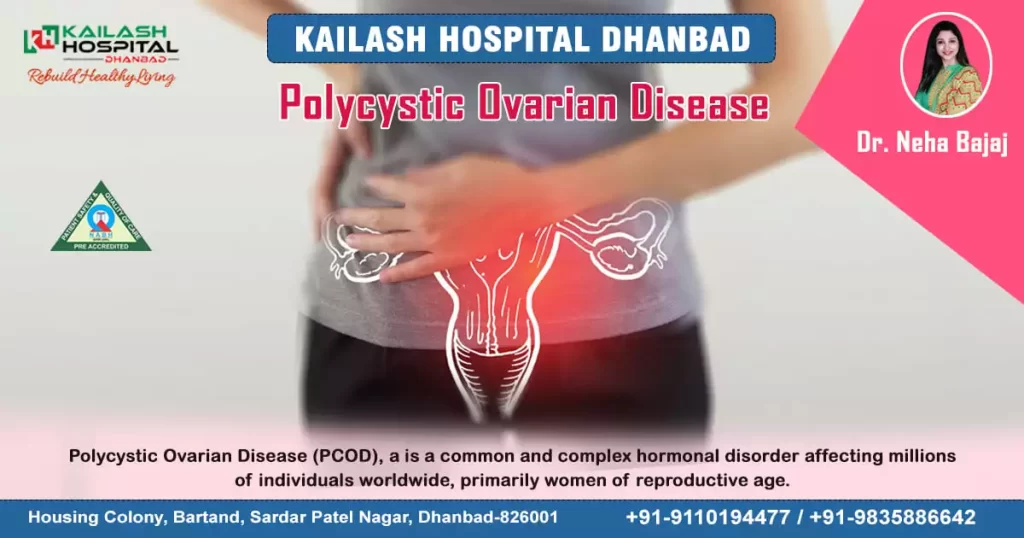
Table of Contents
Polycystic Ovarian Disease (PCOD), is a common and complex hormonal disorder affecting millions of individuals worldwide, primarily women of reproductive age .PCOD is often shrouded in misconceptions and misunderstandings, but by shedding light on this condition, we can empower individuals with knowledge and promote better healthcare.
While it can be challenging to manage PCOD, dealing with bilateral PCOD, which involves both ovaries, can present additional complexities. In this blog post, we will explore PCOD in-depth, from its symptoms and also the causes to management and lifestyle tips.
What is Polycystic Ovarian Disease?
Polycystic Ovarian Disease is a multi-faceted condition characterized by hormonal imbalances, irregular menstrual cycles, and the presence of small cysts on the ovaries.These cysts are often follicles that have not matured properly and can lead to hormone disturbances, resulting in a range of symptoms.
PCOD symptoms
- Irregular or absent menstrual periods.
- Excessive hair growth (hirsutism), often on the face, chest, or back.
- Acne and oily skin.
- Weight gain or difficulty losing weight.
- Scalp hair thinning or hair loss (alopecia).
- Mood swings and depression.
- Pelvic pain.
Symptoms of Bilateral Polycystic Ovarian Disease
Bilateral Polycystic Ovarian Disease shares many symptoms with unilateral PCOD but may present with more pronounced hormonal disturbances. Common symptoms include

- Irregular menstrual cycles or amenorrhea (absence of periods).
- Excessive hair growth (hirsutism) due to increased androgens.
- Acne and oily skin.
- Scalp hair thinning or hair loss.
- Weight gain or difficulty losing weight.
- Mood swings and depression.
- Fertility issues, such as difficulty conceiving.
Causes and Risk Factors of Polycystic Ovarian Disease:
The exact cause of Polycystic Ovarian Disease is not fully understood, however a combination of genetic and environmental factors is believed to play a role. Some key factors include:
1. Insulin Resistance: Insulin resistance is a common symptom of Polycystic Ovarian Disease and can raise insulin levels.This can further stimulate the ovaries to produce more androgens (male hormones), contributing to PCOD symptoms.
2. Hormonal Imbalance: An imbalance in reproductive hormones, including elevated levels of luteinizing hormone (LH) and insulin, can disrupt normal ovulation and lead to the development of cysts on the ovaries.
3. Genetics: PCOD tends to run in families, suggesting a genetic predisposition.
Polycystic Ovarian Disease test names
Hormone Panel
- Follicle-Stimulating Hormone (FSH): FSH levels are often elevated in women with PCOD. High FSH levels indicate that the ovaries are working harder to stimulate follicle development.
- Luteinizing Hormone (LH): Elevated LH levels relative to FSH are common in PCOD. This hormonal imbalance can lead to irregular ovulation.
- Testosterone: Elevated levels of testosterone, a male sex hormone, are often seen in PCOD. This can cause acne, hirsutism (excess facial and body hair), and even hair loss.
- Anti-Müllerian Hormone (AMH): AMH is often used as a marker for ovarian reserve. Women with PCOD tend to have higher AMH levels, indicating a larger number of small ovarian follicles.
Ultrasound Imaging
- Transvaginal Ultrasound: A transvaginal ultrasound can reveal the presence of multiple small cysts on the ovaries, a classic sign of PCOD. The ultrasound also helps in assessing the size and texture of the ovaries
Blood Glucose Tests
- Glucose Tolerance Test (GTT): PCOD is often associated with insulin resistance and an increased risk of type 2 diabetes. A GTT helps diagnose insulin resistance and impaired glucose tolerance
Lipid Profile
- Cholesterol and Triglyceride Levels: PCOD can be associated with abnormal lipid profiles, including elevated cholesterol and triglyceride levels, which increase the risk of cardiovascular disease.
Thyroid Function Tests
- Thyroid Stimulating Hormone (TSH) Test: Thyroid disorders often coexist with PCOD. An elevated TSH level may indicate an underactive thyroid (hypothyroidism), which can exacerbate PCOD symptoms.
Prolactin Levels
- Prolactin Test: Elevated prolactin levels can disrupt the menstrual cycle and cause irregular periods. This test helps rule out other conditions that can mimic PCOD symptoms.
Androgen Levels
- Dehydroepiandrosterone Sulfate (DHEA-S) and 17-hydroxyprogesterone (17-OHP): These androgen hormones can be elevated in PCOD and contribute to the symptoms of hirsutism and acne.
Can Polycystic Ovarian Disease be Cured Permanently?

While there is no definitive cure for PCOD, many individuals can effectively manage their symptoms and lead healthy lives with appropriate treatments and lifestyle modifications. The key to managing PCOD effectively is early diagnosis and a comprehensive approach to treatment.
It’s crucial to remember that therapy outcomes can differ from person to person. Some individuals may experience significant symptom improvement with lifestyle changes alone, while others may require a combination of medications and lifestyle modifications to manage their condition.
Empowering Those Affected
Living with PCOD can be challenging, but it’s essential to remember that you’re not alone. A big impact can be made by asking for help from loved ones, support groups, and medical experts. To manage PCOD, consider the following advice:
- Advocate for Yourself: Be an active participant in your healthcare, ask questions, and seek second opinions when needed.
- Embrace a Healthy Lifestyle: Balanced nutrition and regular exercise can help manage symptoms and improve overall well-being.
- Educate Yourself: Understanding your condition empowers you to make informed decisions about your health.
- Stay Connected: Joining support groups or online communities can provide a sense of belonging and a platform to share experiences and advice.
In conclusion, Polycystic Ovarian Disease is a complex hormonal disorder that does not have a permanent cure. However, it can be effectively managed through a combination of lifestyle changes, medications, and, in some cases, fertility treatments. Early diagnosis and proactive management are essential for individuals living with PCOD to lead healthy and fulfilling lives. While a permanent cure may remain elusive, effective symptom management and a good quality of life are attainable goals for those with PCOD. Consulting with a healthcare provider is crucial to developing a personalized treatment plan, one can also visit to our Kailash hospital where one can get the best consultancy tailored to each individual’s specific needs and goals.



